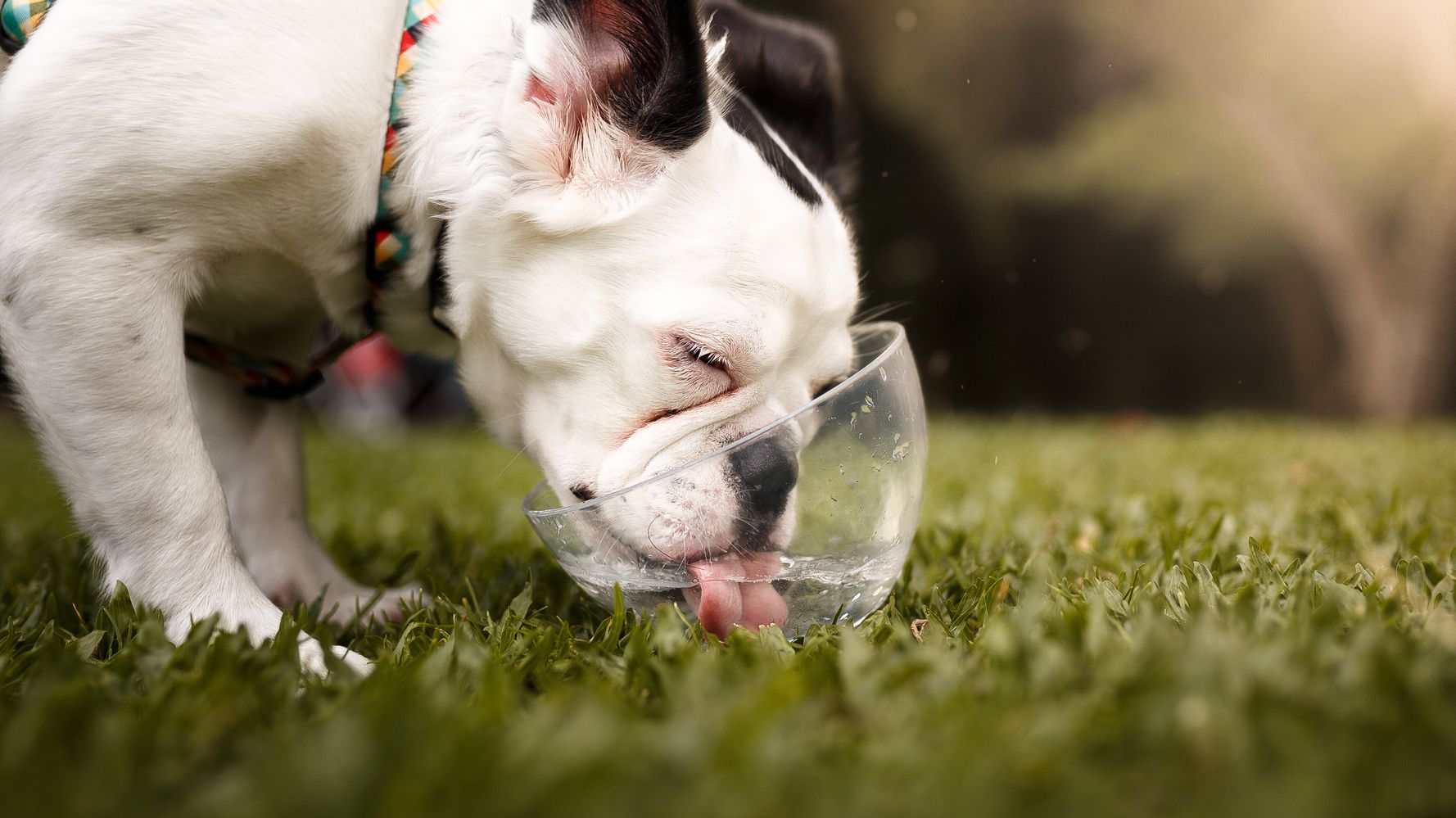Summer 2022 has been a scorcher, with record-setting temperatures and heat waves around the world. People are trying their best to stay cool and healthy, but those with pets are also concerned about their furry friends.
Although dogs famously love to run and play outside, that might not be the wisest move during some of these hot summer stretches. But how can dog owners determine if it’s OK to go for a walk on any given day ― and what can they do to keep them safe when they do step out?
Below, pet experts break down what you need to know about taking your dogs outside in the heat.
Check the the heat index, not just temperature.
“Generally speaking, it is safe to walk a healthy, adult dog when the heat index is 85 degrees or lower,” Dr. Sarah Wooten, a veterinary expert with Pumpkin Pet Insurance, told HuffPost. “Note that is a heat index, not just ambient temperature, because humidity also contributes to the heat index.”
In humid areas, the acceptable temperature range will likely be lower, so make sure to check the heat index or “real feel” measurements before going outside with your pet.
Wooten also noted that you might be OK to walk your healthy adult dog in 90-degree weather if you are walking at a leisurely pace on sticking to dirt or grass, not pavement and asphalt.
Consider your dog’s breed and individual needs.
“Ability to handle heat really depends on the dog’s breed, coat and health status,” said Erin Askeland, an animal health and behavior consultant at Camp Bow Wow. “Dogs with shorter snouts will have a harder time regulating their body temperature and cannot handle hotter temperatures. Dogs with thick coats also may not handle the heat well as they were designed for cold weather. Dogs with health issues, very young, or older dogs may also not be able to handle heat well.”
If your dog has any conditions like heart disease, breathing problems or obesity, pay extra care to keep them cool and shaded.
“Smush-face breeds, like bulldogs, cannot tolerate heat,” Wooten said. “Even normal activity for these dogs can be harmful, so keep at-risk dogs inside as much as possible when the heat index is 85 degrees or higher. Also, greyhounds are at increased risk of heat distress than other breeds. Lastly, don’t shave double-coated dogs. Their fur actually can protect them from heat ― Australian shepherds, huskies, goldens, collies, corgis, etc.”
Test the pavement.
“If where you live is surrounded by pavement, put your hand on the ground,” advised Dr. Heather Berst, a veterinarian and medical lead with Zoetis. “If it feels too hot to the touch, don’t walk your dog on the pavement because their paws could burn.”
Askeland recommended seeing if you can comfortably place your hand on the ground and hold it for 10 seconds.
“While some dog boots can prevent paws coming in contact with the hot surface, it may simply be too hot to walk your dog regardless of paw protection,” she added.
Bring tons of water.
If you determine it’s safe to take your dog for a walk on a hot day, make sure to carry lots of water with you and offer it throughout the outing. Focus on hydration throughout the summer as well.
“Always keep them hydrated,” Wooten said. “In addition to always having water on hand, you can also offer small amounts of water-rich fruit, like melons or berries. You can also add water to their dry kibble to increase hydration, or toss ice cubes made with chicken broth in the water bowl to entice them to drink more.”
Be strategic about timing.
“If it is very hot, it’s better to walk very early or very late in the day to avoid the extreme temperatures and direct sun,” Askeland said.
Going out during cooler times of day and keeping those walks short is best for your dog’s health.
“A quick walk for a bathroom break ― a few minutes ― is tolerated by most dogs but the longer the walk, the more risk of overheating,” said Dr. Dana Wilhite, a consulting veterinarian with Full Moon Pet.
“Treat the walks as a chance to stroll and sniff instead of trying to move quickly or cover a lot of ground,” Askeland added.
Buy cooling products.
“There are some helpful items you can purchase, such as bandanas or vests that can be put in the freezer, to help your pet stay cool,” Berst noted.
A cooling vest or neck wrap can provide relief and protection from the sun. You just soak it in cold water, wring it out and then place it on your dog. Through the process of evaporation, heat is released and there’s a cooling effect similar to sweating for humans.
“Cooling vests can be useful to help keep a dog cool during a walk, but most cooling vests will not last very long,” Askeland cautioned.
Additionally, cooling gel mats and beds are a good option for your dog to use when you return home from a walk.
“The hard, flat surface provides a supportive substrate for them to lay down, while helping to cool them off,” said Dr. Jamie Richardson, head of veterinary Medicine at Small Door Veterinary.
Wooten also offered a DIY toy option for overheated dogs.
“You can freeze water in soda bottles, wrap them in socks, and place them on the floor for the dog to lie beside,” she said.
Limit sun exposure.
“If you do decide to walk your dog on a very hot day, consider doing things that you like to do to personally stay cool yourself on a hot day,” Berst advised. “For example, pick a shaded route or walk on grass versus pounding the payment.”
Take breaks throughout your outing to cool down in shady areas as well. Dogs often continue to move, even when they’re getting overheated.
“Dogs that are avid ball chasers or otherwise very active may not regulate their activity because they’re so focused on chasing the ball,” Wooten noted. “So you will need to do it for them. Monitor when your dog has had enough and be sure to take a break.”
Wooten also suggested using sun protection.
“Dogs can get sunburned, so apply dog sunscreen ― yes, it is a thing! ― and bring an extra umbrella, or make sure there’s some shade to avoid sunburn or heat stroke,” she said.
Pay attention to signs of heat exhaustion.
“Generally, heat exhaustion is a milder form of heat stroke,” Askeland explained, adding that it’s important to know the signs and monitor your dog when they’re outside.
Pay attention to see if they’re ever lagging behind, looking for shade, trying to sit down or hyperventilating.
“A dog may pant heavily, seek water, and take breaks during a walk,” Askeland noted. “These are signs a dog may have heat exhaustion and you should cease the activity, get to a cool area and offer water ― but don’t force your dog to drink. Heat exhaustion can quickly progress to heat stroke, so it’s important to monitor your dog, take its temperature, and go to your veterinarian immediately if symptoms worsen.”
She noted that dogs with heat stroke can have a high temperature, rapid breathing, bright red gums and tongue, dry or tacky gums, and may have trouble balancing or even collapse. Other symptoms include vomiting, excessive drooling, uncontrollable panting and lethargy.
“If heat stroke is a concern, a dog owner should apply cool, wet cloths to the dog’s skin and get to a veterinary hospital immediately,” Askeland said.
Give them cool treats.
What you feed your dog before and after your walk can help counteract the effects of the hot weather.
“Many dogs love ice cubes as a crunchy treat,” Richardson noted. “You can also give them frozen chunks of watermelon or other melon. Just ensure the rind and any seeds are removed, as these can pose a choking hazard. Like ice cubes, these have the added bonus of a high water content ― very useful to keep your pet hydrated on a hot day.”
She recommended using your ice trays to freeze chicken or beef broth (as long as it’s low sodium, fat-free and doesn’t contain onion or garlic) or coconut water with strawberries or blueberries. Another option: buy the dog-friendly “ice cream” that pet brands sell, or make it yourself by mixing mashed-up banana, unsweetened plain yogurt and a tablespoon of creamy peanut butter and freezing it for a few hours.
“You could also make fruity ‘pupsicles’ by diluting fruit juice, so it’s not too sugary,” Richardson added. “Ensure the juice does not contain any artificial sweeteners like xylitol ― it’s toxic to dogs.”
Both Richardson and Wooten are fans of the Kong brand’s signature toy for giving dogs treats that will cool them down.
“Stuff a Kong toy with a soft food and freeze it to create a tasty, long-lasting treat,” Richardson suggested. “Good options include unsweetened plain yoghurt, some mashed banana, canned pumpkin, mashed sweet potato, or canned pet food.”
Find alternatives to your usual walks.
“When it’s very hot, you may not be able to safely walk your dog and can look to indoor games and activities to help your pet get some exercise and mental stimulation,” Askeland noted.
She suggested games like hide and seek, in which you hide and your dog finds you, or a scavenger hunt where hide treats, toys or even their meals throughout the house.
“Set up an indoor obstacle course using pillows, boxes, or other household items,” she added. “Or do short training sessions. Brush up on your dog’s cues or teach them a new trick!”
Wooten noted that very active dogs can be trained to run on indoor treadmills as well.
“If your dog is comfortable, go swimming or engage in water-related activities,” Wooten recommended. “When at home, you can set up a sprinkler, mister or kiddie pool for them to play in. Keep in mind though for lakes, pools and other bodies of water: When the water is above 75 degrees, dogs can still overheat if they are exercising hard in the water.”
Whether indoors or outdoors, however, the most important thing is to take cues from your pet.
“Do not force your dog to exercise in the heat,” Wilhite said. “If they seem like they’d rather not, it’s a good time to take a day off.”


